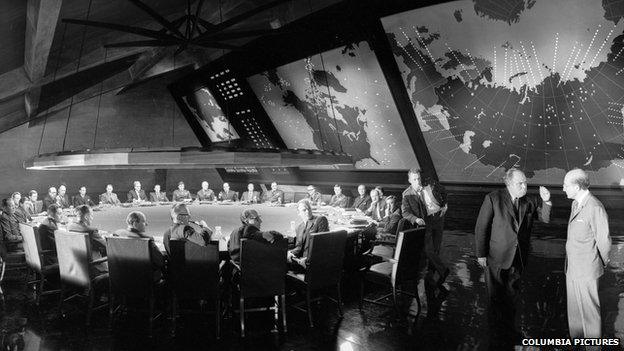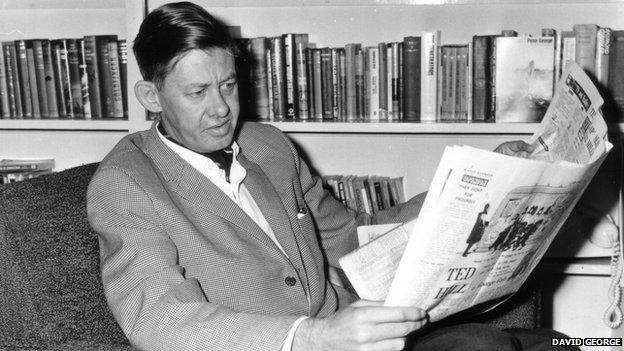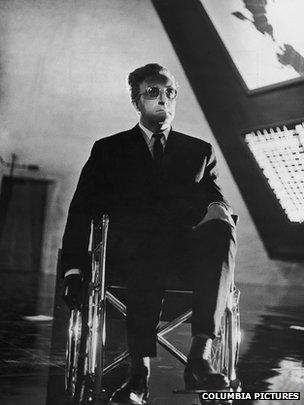Getting to know Dr Strangelove thanks to author Peter George
- Published

The film Dr Strangelove is based on a novel written by Welsh author Peter George
Originally released in 1964, Stanley Kubrick's biting satire of Cold War politics is now regarded as one of the greatest film comedies ever made.
Dr Strangelove or: How I Learned to Stop Worrying and Love the Bomb boasts not one, but three performances by Peter Sellers as different characters including the title character.
In Kubrick's film we know very little about the mysterious, wheelchair-bound 'director of weapons research and development'.
But a newly-discovered work finally reveals just who this enigmatic scientist really was.
The 8,000-word story, Some Notes on the Character of Strangelove Including Strangelove's Theory, was discovered by David George as he was going through his family's archive.
His father, Peter, wrote the original novel on which the film was based.
Planes and bombs
Published in 1958, Two Hours to Doom (known as Red Alert in the United States) was a sober tale exploring the global threat of nuclear annihilation.
It caught the attention of Kubrick, who had just finished shooting Lolita, also starring Peter Sellers.
He wrote to George suggesting they turn the book into a movie.
"It was a three page, handwritten letter," recalls David George.
"It said: 'Hello, my name is Stanley Kubrick, you may have heard of me. I've directed some films like Spartacus and Paths of Glory'.
"I've come across your book and I'd like to make a film about this subject. Yours is the first one that really fits the bill and really comes near to what I'm after.
"It smacks of sincerity and the technical aspects of it all: the planes, the bombs, the tonnage'.
"And, of course, being Kubrick that was that. The project just started rolling very, very quickly."

Peter George was nominated for an Academy Award for co-writing the Dr Strangelove screenplay
By this time, Peter George was already a bestselling novelist, known for his spy thrillers and murder mysteries.
Born in Treorchy, Rhondda Cynon Taff, he had served as an RAF pilot and navigator during World War Two.
His military experience would later shape his career as an author, lending his work an unerring level of detail and precision about the mechanics of warfare.
Inevitably, this fed in to the film.
According to Sellers' biographer Adrian Rigelsford, the filmmakers' vision was often too close for comfort.
"They very much got into trouble with the military authorities because they got too much information right," he said.
"They had guesswork that was so accurate they had the Ministry of Defence land on them like a tonne of bricks.
"For example, the plane that Major Kong is flying, they had no real idea what one looked like, they just guessed and they got it 100% accurate."

Peter Sellers plays Dr Strangelove in Kubrick's film
During the early stages of adapting Two Hours To Doom for the screen, Kubrick and George opted for a shift in tone.
The starkness of the source material was replaced by black comedy. It was during this process that the character of Dr Strangelove was born.
Whole back story
Although George's novel contains elements that also appear in the film, such as the war room and the doomsday machine, the titular scientist does not feature at all.
In fact, it is easy to forget that the character of Dr Strangelove, as memorable as he is, enjoys relatively little screen time in the final cut of the movie.
His motives and history are unclear, a purposely cryptic and tenebrous presence.
However, it seems George had provided a whole back story for the character.
None of the details made their way into the shooting script, but it all helped to flesh out the role of Dr Strangelove and may have provided Sellers with the foundations on which to base his characterisation.
For 50 years, that story remained unseen and unpublished, but that is about to change.
Cardiff-based publishers Candy Jar Books will bring out George's 'new' Dr Strangelove tale later this year.
Shaun Russell from the company believes it is cause for excitement.
"No-one, anywhere in the world, has really seen this before," he said.
"It's essentially Dr Strangelove: The early years. It's how he became Dr Strangelove, and how he developed the theories you see in the film.
"He's a lecturer at university, unhappy with his life and very unhappy about his relationship with women.
"So this story has a woman coming into his life and throwing everything up in the air.
"Then, because of something that happens with the female characters, he sits down and thinks 'how can I plan the end of the world?'"

The 'new' version of Dr Strangelove comes out later this year
The story will be published alongside George's novelisation of the movie, which he wrote to accompany the film's release in 1964.
Many of his books have been out of print for years and his son hopes the discovery of a new Dr Strangelove tale will spark renewed interest in his father's work.
"My quest in life has been to put him back where he needs to be," David George said.
"So Dr Strangelove is the entry point and the jumping off point, to be able to give people these really rather good books to read."
Kubrick's film gained four Academy Award nominations, including one for Peter George as co-writer of the screenplay, along with the director and comic novelist Terry Southern.
George killed himself just two years after the film's release, for reasons that have never fully been understood.
The return of Dr Strangelove marks the first in a planned series of re-issues that will eventually see the entirety of the Welsh author's back catalogue in print for the first time in decades.